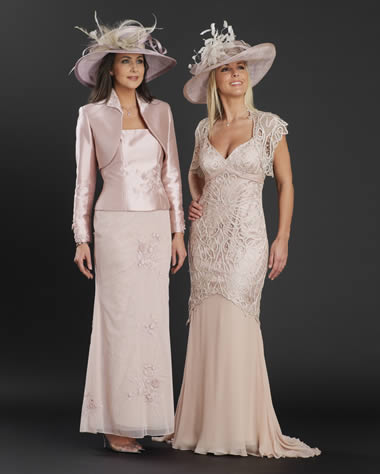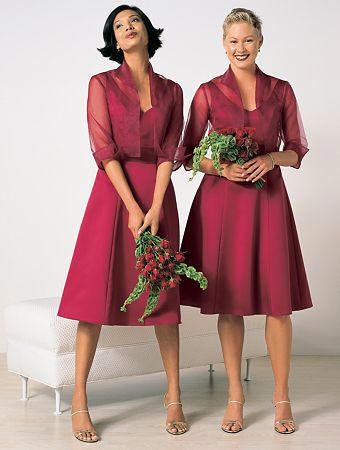Mother Of The Bride Dresses Definition
Source(Google.com.pk) I am so ecstatic that my new show Mother of The Bride is launching tonight on Slice at 9 & 9:30 p.m. ET and in honour of the premiere, I am going to share seven exciting fashion trends for spring!As a co-owner and dress consultant at T.Carolyn Fashions, I navigate the front lines of family conflict -- helping moms look great and satisfying the bride's often strident opinions. Even with 21-years in the business and 100,000 dresses sold, dressing a mother of the bride can be more challenging than dressing the actual bride!
The Spring '13 Collection is the best I've seen in years! Diversity and innovation best describe the latest fashions for Mothers of the bride (or groom).
BLOG CONTINUES AFTER THE SLIDESHOW
Spring Dress Trends for Mothers of the Bride
1 of 16
Mon Cheri
Next
Here are my seven fashion trends for spring:
• Voluminous super soft net skirts, juxtaposed to fitted bodices, creating very dramatic but very feminine gowns.
• One shoulder and asymmetrical necklines
• More updated and flattering fabrics such as net, jersey, stretch taffeta, and fabrics that actually act as Shapewear to hold in those trouble areas most women deal with.
• Layering of differing fabrics such a net over metallic lace over iridescent taffeta -- in different colours to create amazing depth, detail and colour contrast.
• Ruching -- these gathers and pleats are usually diagonal and are extremely flattering.
• Three-dimensional embellishments such as flowers, rosettes, individual petals, and soutache ribbon in generous amounts. These are primarily on the skirts but may also be on a shoulder, jacket or stole.
• Beautiful embellishments such as hand beading, crystals and beading worked into bows, flowers and belts, as well as on the back of dresses and gowns. It's all in the details!
If you want to delve further into the exciting world of weddings, I invite you to tune into my new show Mother of The Bride premiering back-to-back episodes on Friday, January 4 on SliceTM. Visit slice.ca for exclusive blogs, a mother of the bride dress guide, cast bios and full episodes. Join our Mother of The Bride Facebook page as well!
While speculation over Catherine Middleton’s dress has apparently consumed most of the fashion world, Vogue takes a longer view. We look back at a century of royal brides and their style choices, as chronicled in the magazine.
Vogue announced the engagement of Lady Elizabeth Bowes Lyon to His Royal Highness the Duke of York in March 1923; in her portrait by Beck and Macgregor, her profile is framed by the upstanding fur collar of her coat and by a velvet hat trimmed with ostrich feathers.
In June of that year, Vogue published an elaborate drawing of the wedding ensemble that she chose, with its dress “of silver lamé embroidered with seed pearls suggesting a medieval Italian robe,” veiled in lace lent by the groom’s mother, Queen Mary, (and no tiara—just a chaplet of leaves). The whole look was an apt complement to the soaring perpendicular arches of the Abbey’s inspiring architecture—and to a storied setting that saw its first royal wedding in 1100 when Henry I of England married Matilda of Scotland.
The dress was made, as custom decreed, by a British couturier, in this case, the distinguished and conservative court dressmaker Madame Handley Seymour (who would later make Elizabeth’s 1937 coronation gown). However, its design was closely based on a dress created by the Parisian couturier Jeanne Lanvin, whose romantic designs accorded with the taste of Lady Elizabeth of Glamis.
(Queen Elizabeth the Queen Mother’s granddaughter, Princess Anne, also looked to the Middle Ages for inspiration when she wore a dress with hanging sleeves and embroidery of pearl trelliswork, designed for her by Maureen Baker of the Susan Small label, for her first marriage, to Captain Mark Phillips in 1973).
Queen Elizabeth’s daughter Princess Elizabeth (later Queen Elizabeth II), looked to the Renaissance when she wed the dashing young captain Philip Mountbatten in 1947—or at least her couturier Norman Hartnell (later knighted for his efforts in creating iconic images for two generations of royal ladies) cited Botticelli’s c.1482 painting Primavera as the inspiration for the elaborate embroidery motifs of scattered flowers on the rich duchesse satin dress and the tulle veil. The theatrically minded Hartnell, whose clients included royalty, society beauties, actresses, and the romance novelist Barbara Cartland, was famed for his magnificent embroideries, and he employed hundreds of embroiderers in his Mayfair workrooms.
Princess Elizabeth had first been dressed by Hartnell when she and her sister, Princess Margaret Rose, were bridesmaids at the 1935 wedding of her uncle the Duke of Gloucester to Lady Alice Christabel Montagu Douglas Scott (who was dressed by Hartnell in remarkably understated blush-pink satin; her father had recently died, and the planned stately wedding was dramatically scaled down as a result).
In the face of postwar austerity, hundreds of brides-to-be across the country sent Princess Elizabeth their clothing coupons so that she could have the dress of their dreams.
When Elizabeth’s fashionable sister Princess Margaret married Antony Armstrong-Jones (a sometime Vogue photographer) in 1960, the couple encouraged Hartnell to suppress his more exuberant fantasies and instead (and very much against his own instincts) produce a streamlined version of the hourglass ball-gown silhouette that suited her Elizabeth Taylor–like figure: acres of masterfully worked white organza with no embellishment at all. Vogue declared her “a new princess; her dress, unadorned, struck a clear true note.”
Lady Diana Spencer looked to relatively unknown designers—David and Elizabeth Emanuel, recently graduated from the Royal College of Art—when she wed Prince Charles in 1981. Lady Diana was first introduced to the Emanuels’ work when she wore one of their feminine blouses for a Vogue sitting with Lord Snowdon (the self-same Tony Armstrong-Jones). The Emanuels’ wildly romantic Victorian wedding dress, with its 25-foot-long cathedral train and frothing ruffles fulfilled the public fantasy of a fairy-tale princess. (The nineteen-year-old Lady Diana wore a somewhat aging Cojana suit of sapphire blue for her official engagement photograph and interview with Prince Charles. Miss Catherine Middleton chose a dress of the same color for her photo call with Prince William, but its sleek and body-revealing lines illustrated her own fashion assurance.)
But of course nothing could be further removed from the majesty and romance of these royal brides’ choices than the austere dress and jacket of “Wallis Blue”—a very strong forget-me-not blue that set off her eyes and her sapphire-and diamond-clip—that Wallis Warfield chose when she shocked the world by wedding the Duke of Windsor in 1937. The Duke had of course renounced his throne to marry the woman he loved. Cecil Beaton, exclusively photographing the bridal couple and reporting on the day for Vogue, noted that the dress gave “the bride-to-be the fluted lines of a Chinese statue of an early century.” (In his private diaries, however, he observed how underwhelming the ensemble was for the occasion.)
Wallis wore pieces by Schiaparelli and Mainbocher for the portfolio of engagement photographs taken earlier by Beaton; she was, of course, under no obligation to dress British even for her wedding. Instead she looked to the Chicago-born, Paris-based couturier Main Bocher, whose own rigorous sense of expensive, disciplined elegance was perfectly attuned to her own.
Fearing that no British museum would accept, she later gifted the dress to the Costume Institute of the Metropolitan Museum of Art where it resides to this day.
See our slideshow above featuring a century of royal brides.
The story of Ursula, a young Swiss woman's tireless efforts to grow a multi-million dollar company from forty-eight cents. It was by creating hats, particularly for Henri Bendel and Saks Fifth Avenue that Ursula parlayed her profits into fashionable creations that caught the eye of Manhattan buyers.
In 1965, romance entered Ursula's life and swept her from New York's garment center to Upstate New York, where in Schenectady, her first dress making venture was thus born with 15-20 employees. In 1967 URSULA OF SWITZERLAND was founded, and later incorporated in 1969. Simultaneously, URSULA OF SWITZERLAND, INC., RETAIL SHOPS kept Ursula's ear close to her customers - with four locations in Albany, Schenectady, Troy, and Saratoga; however, in years to come, Ursula's burgeoning wholesale business eventually eliminated the need for retail positioning. in 1972, URSULA OF SWITZERLAND, INC., moved to a historic site, a former 19th century ribbon factory nestled on the banks of the Hudson / Mohawk Rivers, in Waterford. Here, concentration on design and production saw a surge in revenues.
In 1988, the combined efforts of the URSULA OF SWITZERLAND, INC.'S SHOWROOM on Broadway, eleven Road Representatives nationally situated in major Apparel Marts and an unparalleled Customer Service Department in Waterford, won URSULA OF SWITZERLAND, INC., the DEBI AWARD for Distinguished Excellence in the Bridal Industry - national recognition - specifically for Special Occasions. This accolade would be repeated in future years.
Since 1994, Ursula's focus on Mother-of-the-Bride, for the petite, missy and plus sized woman, has found her a winning niche in over 5000 Better Bridal Stores. We also sell internationally to Mexico, Canada, South America, England, New Zealand, Caribbean, and Sweden & Australia. The URSULA OF SWITZERLAND, INC.'S "Made in America" Collections are renown internationally for the consistent quality, fit, styling and value along with the recognizable aura of femininity and elegance. In September 1992, Ursula assumed the post of President and sole owner of URSULA OF SWITZERLAND, INC.
Mother Of The Bride Dresses
 |
Mother Of The Bride Dresses
 |
Mother Of The Bride Dresses
 |
Mother Of The Bride Dresses
 |
Mother Of The Bride Dresses
 |
Mother Of The Bride Dresses
 |
Mother Of The Bride Dresses
 |
Mother Of The Bride Dresses
 |
Mother Of The Bride Dresses
 |
No comments:
Post a Comment